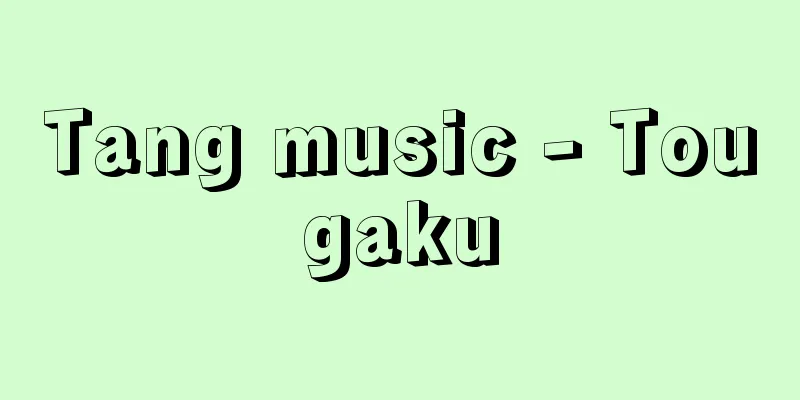Tang music - Tougaku

|
A central branch of Japanese gagaku. From the Nara period to the early Heian period, ensemble music was introduced from China during the Tang Dynasty, and it was primarily entertainment music for the Tang Dynasty court. It also includes music from India and Vietnam that was introduced via China, and music composed by Japanese people that imitated them. When it was first introduced, it was performed as music for temple offerings or as ceremonial music for the court. In the mid-Heian period (around the time of Emperor Ninmyo), the so-called Heian Dynasty musical reform unified the instrument arrangement, musical theory, and performance style, and it was shaped as Tang music in contrast to the Korean-based Komagaku, and it has remained that way to this day. There are over 70 pieces of Tang music today, and they can be divided into three types based on the performance style: (1) pieces exclusively for orchestra (played only with instruments), (2) pieces exclusively for Bugaku (played with dance and instruments), and (3) pieces for both orchestra and Bugaku. The wind instruments used in orchestral music are the hichiriki, ryuteki, and sho, the stringed instruments the koto and biwa, and the percussion instruments the taiko, gong, and kakko. They are performed gracefully at a slow tempo, taking advantage of the characteristics of each instrument. Bugaku, on the other hand, does not use stringed instruments, but instead uses wind and percussion instruments, and is performed at a relatively fast tempo with a clear rhythm. Tang music is made up of one of six scales (six rhythms): Ichikotsu, Hyojo, Sojo, Oushiki, Banshiki, and Taishiki. The rhythm is one of the following: Jobyō, Hayashibō, Hayahappyō, Enshibō, Enshibō, Hayatadayō, and Yotarahappyō. Source: Encyclopaedia Britannica Concise Encyclopedia About Encyclopaedia Britannica Concise Encyclopedia Information |
|
日本の雅楽の中心となる一部門。奈良時代から平安時代初期にかけて,唐代の中国から伝来した合奏音楽で,唐朝の宮廷の娯楽音楽を中心とするが,このほか,中国を経て伝来したインドやベトナムの音楽,それらをまねて日本人が作曲した音楽が含まれる。伝来当初から寺院の供養音楽として,あるいは宮廷の儀式音楽として演奏され,さらに平安時代中期 (仁明天皇の頃) には,いわゆる平安朝の楽制改革によって,楽器編成や音楽理論,演奏様式などの統一がはかられ,朝鮮系の高麗 (こま) 楽に対する唐楽として形が整えられ,今日にいたっている。現行の唐楽は七十数曲を数えるが,演奏様式からは (1) 管弦専用の曲 (楽器だけによる演奏) 。 (2) 舞楽専用の曲 (舞と楽器による演奏) 。 (3) 管弦,舞楽両用の曲の3種に分類できる。楽器は,管弦には,管楽器の篳篥 (ひちりき) ,竜笛 (りゅうてき) ,笙,弦楽器の箏,琵琶,打楽器の太鼓,鉦鼓,羯鼓 (かっこ) を用い,個々の楽器の特徴を生かして,ゆるやかなテンポで優美に演奏される。また舞楽では弦楽器を用いず,管,打楽器によって,拍節を明確に,テンポも比較的早く演奏される。唐楽曲は壱越 (いちこつ) 調,平調 (ひょうぢょう) ,双調 (そうぢょう) ,黄鐘 (おうしき) 調,盤渉 (ばんしき) 調,太食 (たいしき) 調という6種の音階 (六調子) のいずれかによって成り立っており,またリズムに関しては序拍子,早四拍子,早八拍子,延四拍子,延八拍子,早只四拍子,夜多羅八拍子などのいずれかによって構成される。
出典 ブリタニカ国際大百科事典 小項目事典ブリタニカ国際大百科事典 小項目事典について 情報 |
Recommend
Model Wage
-A model of wage trends when a person employed by ...
Cladorhynchus leucocephalus (English spelling) Cladorhynchusleucocephalus
… [Shinji Takano]. … *Some of the terminology tha...
Voss, CF (English spelling) VossCF
…Germany's top-class newspaper. Founded in Be...
Sunrise - Gorakko
〘Noun〙 ("Go" is a prefix) ① The sunrise ...
Zheng-guo-qu; Chêng-kuo-ch`ü
This irrigation canal was built by Zheng Guo of Ha...
Respiratory acidosis
…The pH of body fluids is normally maintained at ...
Brazier - Bath
A summer hearth used to place a kettle on and boi...
Naniwa Story - Naniwa Monogatari
A record of the reputation of prostitutes. Author ...
Murata Seifu
Year of death: May 26, 1855 (July 9, 1855) Year of...
Pocket warmer ash - Pocket warmer
〘 noun 〙 A solid fuel that is lit and placed in a ...
Kokubunji [town] - Kokubunji
A former town in Ayauta County, located in central...
Edamame tofu - Edamame tofu
…Edamame are boiled in salt and used as a snack w...
Kobunen (English)
A Chinese anthology of poetry and prose. The edito...
Magnetomotive force
The quantity of magnetism corresponding to the ele...
Balanced Budget
...In other words, it would be more accurate to s...









